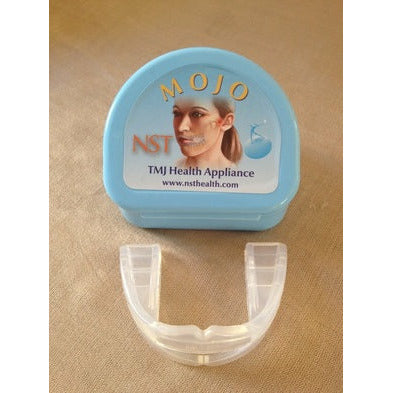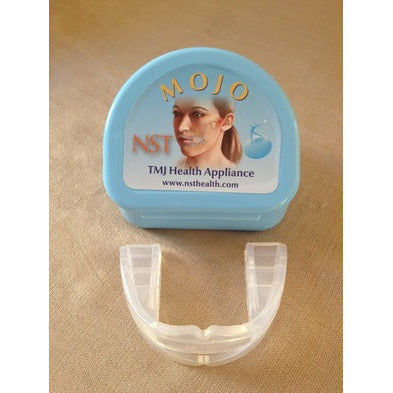SENTIENT Wellbeing
MOJO Mouth Device
MOJO Mouth Device
Couldn't load pickup availability
MOJO Mouth Device
|
What is the Mojo Mouth Device?
The MOJO is a flexible silicone mouth appliance (orthotic) which can be used day or night. Its aim is to assist resolution of TMD (Temporo Mandibular Dysfunction) by reducing inflammation, pain, popping and clicking in the jaw joint known as the TMJ (Temporo Mandibular Joint); restore range of motion over time, reset the resting length of tight jaw muscles and reduce or eliminate clenching/grinding habits.
How does the MOJO work?
MOJO creates space in the jaw joint by bringing the lower jaw forward. The effect is to open the TM Joint and stretch the jaw muscles. This results in releasing pressure inside the joint. Over time that allows
|
|
How is the MOJO different from a Dental Splint?
- MOJO is significantly less expensive at NZ$110 than a hard plastic dental splint which can be moulded by your dentist and can cost around NZ$400-$600
- Softer in the mouth
- MOJO doesn’t need to be fitted
- Can be worn during the day. Most people wear their MOJO at home after work for a while and carry on watching tv, working on their computer, preparing dinner
- Walking around wearing your MOJO is useful because it helps reset the neural patterns which perpetuate a clenching habit
- Feedback from clients indicates that MOJO is helpful when used as little as 5 – 30 minutes a day 3 x per week. More often is better.
- Exercises can be added – see MOJO brochure
- 3 Weeks is usually enough to get a good change. After initial resolution, most people keep their MOJO in the bathroom cupboard till they experience another stress patch then bring it out for a week or so to reset their clench response to stress.
- Can be used overnight to help with snoring or speed TMJ healing.
What is TMD?
TMD (Temporo Mandibular Dysfunction) is the term given to jaw joint problems which may occur in the bones and disc of the jaw joint itself (located just in front of your ear) or the surrounding muscles of the face, head and neck.
TMD a joint problem; Watch the first clip above
TMD a muscle problem; Watch the second clip above
With a healthy TM Joint the lower jaw will have a straight vertical line of travel when opening/closing the mouth, make no sound on movement and be able to open wide as well as move from side to side with no sense of tightness or pain.
TMJ (Temporal Mandibular Joint) is one of the most complex joints in the body and powerfully affects not just the jaw, face, head, neck and teeth – but also can affect nerve function to other parts of the body.
Your TM Joint is affected whenever you chew, swallow, talk, yawn, clench or grind your teeth and every time you take a breath.
For perspective on how powerfully a dysfunction in the TMJ can affect the entire body, watch Dr Stark’s clips below. Note that Dr Stark treats his patients with bespoke dental implants. The MOJO is a removeable dental orthotic and does not claim to achieve the effects that Dr Stark achieves with fixed implants.
Symptoms of TMD
- Pain in the area of the TM Joint (in front of your ears) or cheek and head muscles including headaches, fuzzy head
- Limited movement of the lower jaw (mandible)
- Pain/sensitivity in upper teeth
- Tooth surface wear which your dentist can identify. It is caused by night teeth grinding (Bruxism)
- Waking in the morning with headache (could be caused by Trigger Points in the jaw muscles)
- Waking with a tight/stiff jaw that will not easily open (you should comfortably fit 4 fingers between upper and lower teeth)
- Clicking, popping or graunching sound in the joint
- Sinus problems
Treatments for TMD
Splint Therapy
Orthotic Therapy – i.e. the MOJO
Chiropractic
Massage therapy
Share



